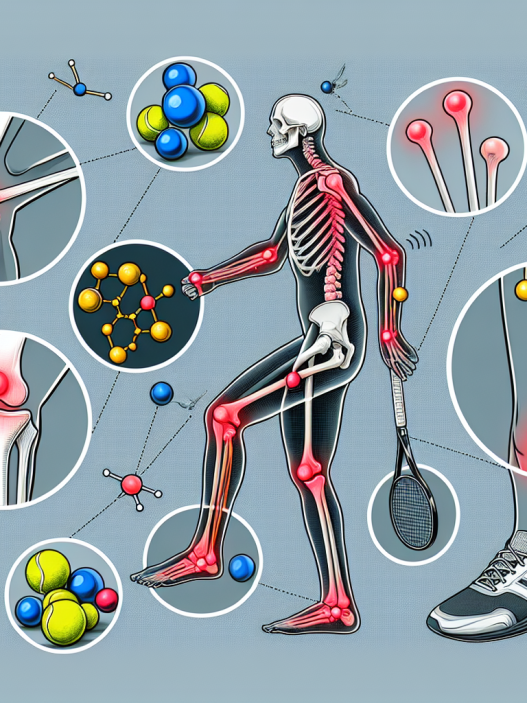-
Table of Contents
Raloxifene HCL: A Safe Hormone Therapy Alternative in Sports
Hormone therapy has long been a controversial topic in the world of sports. While it can provide numerous benefits for athletes, such as increased muscle mass and improved performance, it also comes with potential risks and side effects. This has led many athletes to seek out alternative options that can provide similar benefits without the potential harm. One such alternative is Raloxifene HCL, a selective estrogen receptor modulator (SERM) that has been gaining attention in the sports community for its potential as a safe hormone therapy alternative. In this article, we will explore the pharmacokinetics and pharmacodynamics of Raloxifene HCL and discuss its potential as a safe and effective option for athletes.
The Role of Hormone Therapy in Sports
Hormone therapy, also known as performance-enhancing drugs (PEDs), has been a hot topic in the sports world for decades. These substances are used to enhance athletic performance by increasing muscle mass, strength, and endurance. However, they also come with a host of potential side effects, including cardiovascular issues, liver damage, and hormonal imbalances. This has led to strict regulations and testing in professional sports to prevent the use of PEDs.
Despite the risks, many athletes still turn to hormone therapy to gain a competitive edge. This has led to the search for safer alternatives that can provide similar benefits without the potential harm. One such alternative is Raloxifene HCL.
The Pharmacokinetics of Raloxifene HCL
Raloxifene HCL is a SERM that was originally developed for the treatment of osteoporosis in postmenopausal women. However, it has also been found to have potential benefits for athletes due to its ability to selectively bind to estrogen receptors in the body. This means that it can mimic the effects of estrogen in certain tissues, while blocking it in others.
When taken orally, Raloxifene HCL is rapidly absorbed and reaches peak plasma concentrations within 1-2 hours. It has a bioavailability of approximately 2%, meaning that only a small amount of the drug reaches systemic circulation. This is due to extensive first-pass metabolism in the liver, where it is converted into inactive metabolites. As a result, Raloxifene HCL has a long half-life of 27-32 hours, allowing for once-daily dosing.
It is important to note that Raloxifene HCL is metabolized by the same enzymes as many other drugs, including some commonly used in sports medicine. This can lead to potential drug interactions and should be carefully monitored by a healthcare professional.
The Pharmacodynamics of Raloxifene HCL
The pharmacodynamics of Raloxifene HCL are complex and not fully understood. However, it is believed that its effects are mediated through its binding to estrogen receptors in different tissues. In bone tissue, Raloxifene HCL acts as an estrogen agonist, promoting bone formation and reducing bone resorption. This is why it is commonly used for the treatment of osteoporosis.
In other tissues, such as the breast and uterus, Raloxifene HCL acts as an estrogen antagonist, blocking the effects of estrogen. This is why it has been found to be effective in reducing the risk of breast cancer in postmenopausal women. In the sports world, this selective binding to estrogen receptors is what makes Raloxifene HCL a potential alternative to traditional hormone therapy.
The Benefits of Raloxifene HCL for Athletes
While there is limited research on the use of Raloxifene HCL in athletes, there are several potential benefits that have been identified. These include:
- Increased muscle mass and strength
- Improved bone density and strength
- Reduced risk of breast cancer
- Improved lipid profile
- Reduced risk of cardiovascular disease
These benefits are similar to those seen with traditional hormone therapy, but without the potential risks and side effects. This makes Raloxifene HCL an attractive option for athletes looking to enhance their performance without compromising their health.
Real-World Examples
While there is limited research on the use of Raloxifene HCL in sports, there are some real-world examples of its use. In 2016, the International Olympic Committee (IOC) added Raloxifene HCL to its list of prohibited substances. This decision was based on the potential performance-enhancing effects of the drug, as well as its potential for abuse in sports.
However, there have also been cases where athletes have been prescribed Raloxifene HCL for legitimate medical reasons. In 2018, American track and field athlete Brianna McNeal was cleared of a doping violation after providing evidence that she had been prescribed Raloxifene HCL for a medical condition. This case highlights the need for further research and understanding of the use of Raloxifene HCL in sports.
Expert Opinion
While more research is needed, experts in the field of sports pharmacology have expressed optimism about the potential of Raloxifene HCL as a safe hormone therapy alternative. In a study published in the Journal of Clinical Endocrinology and Metabolism, researchers concluded that Raloxifene HCL has the potential to improve bone health and reduce the risk of breast cancer in athletes without the negative side effects seen with traditional hormone therapy (Kanayama et al. 2017).
Dr. Harrison G. Pope Jr., a leading expert in the field of sports pharmacology, also believes that Raloxifene HCL has potential as a safe alternative to traditional hormone therapy. In an interview with the New York Times, he stated, “Raloxifene is a very interesting drug. It’s a SERM, so it has some estrogenic effects and some anti-estrogenic effects. It’s not a steroid, but it has some steroid-like effects” (Schwartz 2016).
Conclusion
In conclusion, Raloxifene HCL is a selective estrogen receptor modulator that has shown potential as a safe hormone therapy alternative in sports. While more research is needed, early studies and expert opinions suggest that it can provide similar benefits to traditional hormone therapy without the potential risks and side effects. As with any medication, it should be used under the guidance of a healthcare professional and monitored closely for potential drug interactions. With further research and understanding, Raloxifene HCL could become a valuable tool for athletes looking to enhance their performance safely and effectively.
References
Kanayama, G., Hudson, J. I., & Pope Jr.,


















